"Minneapolis-based NextMedia runs full-motion video ads transformed into 3D and projected from screens in upscale pubs. Ads are placed on flat-panel screens in bars and nightclubs and appear in 3D. Special glasses aren’t required to view the ads. The program is called NightVision. The ads comprise 50 percent of a two-and-one-half-hour loop. The other half is devoted to enterntainment, such as movie trailers and clips, and promotions for the particular nightspot, such as drink specials, upcoming acts and ladies' nights. Only the ads are in 3D. They are 30 seconds in length and are played 15 times during the loop. Advertisers can sponsor the network, including the entertainment segments."
-- Media Life
Advertising with WinAmp Skins

Product websites these days offer all kinds of downloadable stuff, from desktops and screensavers to IM buddy icons. How come so few of these websites offer customized WinAmp skins? The one pictured above and installed on my computer mimics a pack of Wrigley gum (you can get it here), but was done by a fan, Denis Bernard. Movie publishers seem to be ahead of the rest; there are skins for Narnia, Corpse Bride, Batman Begins and Troy and a few others that seem to be commissioned by the studios. Pepsi and Powerade seem to get it, too. Most of other branded skins - very good ones, too - are made by fans. There are skins styled after iPod nano, Pioneer, Sony, Puma, Pizza Hut, Nokia.
I think this by far beats advertising through browser skinning.
WinAmp's latest 5.1 version has been downloaded over 4.5 million times. That's only one version for one operating system (Windows) on one site Downloads.com. The first WinAmp was released in 1997. The install base for this thing should be huge by now.
Disappearing Advertising

So, this is like the self-destructing text messages, only on paper:
"This invitation to a free screening of the latest Harry Potter film was sent by Coca-Cola to executives fo important Spanish companies. You had to rub the surface with a wet cloth to see the text. After a while it would disappear again." (McCann-Erickson Spain, 2005 Silver Gold Medal at New York Festival.)
And while we are at it, here's where you can buy "black light" paint, that is paint visible in black light but transparent otherwise.
The Word of 2005: Integrity
Offtopic.
Merriam-Webster has announced the top ten words of 2005 based on user online look-ups. Last year the top word was "blog", a year before it was "democracy". This year it's "integrity". I wonder if it's a good or a bad sign. It must be good that so many are interested in integrity, but sort of troubling that people need to look it up.
One of the more esoteric words on the list is "insipid", and here's the story behind it making to the top: "Immediately after Simon Cowell, the acid-tongued host of the popular television show "American Idol," called one aspiring singer "insipid," Merriam-Webster noticed a dramatic spike in the number of lookups for the word, which the dictionary defines as 'lacking in qualities that interest, stimulate or challenge: dull, flat.'" (CBS)
Merriam-Webster has announced the top ten words of 2005 based on user online look-ups. Last year the top word was "blog", a year before it was "democracy". This year it's "integrity". I wonder if it's a good or a bad sign. It must be good that so many are interested in integrity, but sort of troubling that people need to look it up.
One of the more esoteric words on the list is "insipid", and here's the story behind it making to the top: "Immediately after Simon Cowell, the acid-tongued host of the popular television show "American Idol," called one aspiring singer "insipid," Merriam-Webster noticed a dramatic spike in the number of lookups for the word, which the dictionary defines as 'lacking in qualities that interest, stimulate or challenge: dull, flat.'" (CBS)
Digital Sound Bag

Hand out fliers with a bang. If you have promo teams on the streets, you might want to equip them with this digital sound bag that comes with a pair of built-in speakers and a pocket for an iPod.
-- via Pop Gadget
Sound Branding: Podcasts, Ringtones, and Digital Radio
Nick Wreden, the author of ProfitBrand (reviewed earlier), has a new feature on Brand Channel about advertising on podcasts, the pervasiveness of ringtones, and the future of digital radio. Some quotes:
"In the fall of 2004, GM used a podcast to help introduce its 2005 vehicle line-up. Microsoft soon followed suit; now dozens of companies use podcasts as part of their branding mix."
"Unlike Internet advertising, which requires consumers to be tethered to a PC, podcasts have the advantage of being time-shifted as easily as a TiVo. Consumers can listen to podcasts at their convenience, which reduces distractions and increases receptivity. One disadvantage, however, is a lack of measurement. Because the podcasts are listened to away from the computer, real-time tracking is impossible. As a result, some podcast advertisers are testing the use of toll-free numbers or other direct response vehicles."
"In addition to offering cable-like access to hundreds of channels, digital radio lets listeners pause, rewind and time-record high-quality broadcasts. Additionally, relevant information such as artist and album information can be transmitted. Digital radios will be able to transmit scrolling news, traffic reports or ads to the radio's screen. As screens get larger, traffic maps can accompany traffic reports, or logos or other visuals can be displayed on the screen during ads. Channels, sub-channels and even sub-sub-channels will allow advertisers to target segments more precisely. Some are even talking about coordinating digital radio with the GPS system to deliver ads specific to the listener's location."
Also, see an earlier Brand Channel's article on sonic branding.
"In the fall of 2004, GM used a podcast to help introduce its 2005 vehicle line-up. Microsoft soon followed suit; now dozens of companies use podcasts as part of their branding mix."
"Unlike Internet advertising, which requires consumers to be tethered to a PC, podcasts have the advantage of being time-shifted as easily as a TiVo. Consumers can listen to podcasts at their convenience, which reduces distractions and increases receptivity. One disadvantage, however, is a lack of measurement. Because the podcasts are listened to away from the computer, real-time tracking is impossible. As a result, some podcast advertisers are testing the use of toll-free numbers or other direct response vehicles."
"In addition to offering cable-like access to hundreds of channels, digital radio lets listeners pause, rewind and time-record high-quality broadcasts. Additionally, relevant information such as artist and album information can be transmitted. Digital radios will be able to transmit scrolling news, traffic reports or ads to the radio's screen. As screens get larger, traffic maps can accompany traffic reports, or logos or other visuals can be displayed on the screen during ads. Channels, sub-channels and even sub-sub-channels will allow advertisers to target segments more precisely. Some are even talking about coordinating digital radio with the GPS system to deliver ads specific to the listener's location."
Also, see an earlier Brand Channel's article on sonic branding.
Papercraft Advertising

Yamaha's website offers layouts and assembly instructions to help you create realistic (and, of course, branded) papercraft motorcycle models. Also, see a similar post on BWM-themed papercraft in Taiwan. If that's your thing, see a collection at MAKE for even more stuff.
Advertising on Blackboard T-shirt

If you already have a blackboard mug, you will definitely need a matching blackboard t-shirt. Who needs CafePress with their black tees, when you can have a new design every day.
-- via Red Ferret; you can find a few other things with built-in chalkboards here.
iPod-Compatible Payment Terminal
"Ingenico's research teams have developed the world's first-ever terminal accepting a payment on an iPod. Ingenico’s i5100 terminal integrates with Atlantic Radio System’s FM data extraction module, allowing it to communicate with the iPod via the FM band while enabling users to pay for goods using their MP3 player. Ingenico demonstrated how, in a hypothetical future, travellers could book plane tickets and receive them via MP3 format by e-mail. They would then just need to store the MP3 receipt on an iPod before going to the airport."
-- press release
-- press release
Future: Packaging Made Of Electronic Paper

Wired: "Electronics maker Siemens is readying a paper-thin electronic-display technology so cheap it could replace conventional labels on disposable packaging, from milk cartons to boxes of Cheerios. In less than two years, Siemens says, the technology could transform consumer-goods packaging from the fixed, ink-printed images of today to a digital medium of flashing graphics and text that displays prices, special offers or alluring photos, all blinking on miniature flat screens."
Add sound to the mix, too.
Earlier:
- Study: Packaging Design Patterns
- Friday Special: Museum of Packaging
- Simpill: Packaging with SMS Reminder
- Flashback: Cereal Box Carboard Records
- Ethnographic Research on Packaging Usage
(Pictured above:A Citizen employee unveils the world's first flexible digital clock which is as thin as camera film and can be bent around the curve of a wall; Yahoo.)
Advertising on Turnstiles

"Monster Media recently unveiled the first-ever transit application of its patented Turnstile AdSleeves as part of a unique pilot program with Viacom Outdoor. Nearly 300 turnstiles are now dressed with the adsleeves bearing insurance provider Geico's message."
-- press release
That, of course, in addition to advertising on escalator handrails (company, flickr pic).
Earlier:
Viacom Launches Digital Posters
PSA: ihaveanidea Promotes Original Thinking With New Campaign

Public Service Announcement:
A Canadian site ihaveanidea (andspellcreatively) is launching three online video ads promoting original thinking in advertising. Their blurb says that the campaign also "humorously illustrates how great ads become a part of pop culture and are recognized and celebrated by people from all walks of life." Don't know about "celebrated", but you are going to love this ad with a stripper, if their server survives the traffic.
Camera Phones and Barcodes Tie Billboards and Web

I already posted about campaigns that use barcodes, camera phones and traditional media to create a "transmedia" campaigns, and AdRants brings the topic back into the limelight with its post on Northwest Airlines' campaign in Japan using QR codes by
[Update: April 2, 2006] QR Codes are a product of Denso Wave. Semacode Tags are by Semacode.
Earlier:
PaperClick, FCB Tie Barcodes and Cellphones
SoundAds: Print and Sound
Feedback to Print Ads Through Camera Phones
Digital Billboards: Overview
Study: Ad Skipping Is DVR Users' Favorite Feature
Adweek: "New research on digital video recorders by WPP Group's Mindshare found that consumers buy the devices mainly to "time shift" (record programs for later viewing) and skip commercials. Among those who already own a DVR, about 90 percent cited time-shifting capability and nearly 80 percent mentioned the ability to skip commercials as their favorite features.
The study, which quizzed 1,200 consumers about their media consumption, also found that the DVR is the top media gadget consumers plan to acquire over the next six months."
The article says the study contradicts an earlier assertion by the networks that "their internal research found that consumers' top reason for purchasing a DVR was the ability to time shift, while commercial skipping was far down on the priority list."
Here's the original story on the networks' joint press conference as reported by the Associated Press. It mentions nothing about this assertion.
The study, which quizzed 1,200 consumers about their media consumption, also found that the DVR is the top media gadget consumers plan to acquire over the next six months."
The article says the study contradicts an earlier assertion by the networks that "their internal research found that consumers' top reason for purchasing a DVR was the ability to time shift, while commercial skipping was far down on the priority list."
Here's the original story on the networks' joint press conference as reported by the Associated Press. It mentions nothing about this assertion.
ASIMO Robot Fetches Coffer, Readies for Career in Advertising

If a robot can fetch coffee, it should also be able to hand out flyers on the streets, right? Welcome, Asimo.
More Predictions for 2006
More predictions (you'll need to register to read) for the new year's advertising industry, this time from Carat's SVP:
- User-generated content will be king.
- Video-on-demand will start to incorporate advertising.
- Mobile advertising will come into its own.
- In-game advertising is going to explode
- There will be some element of backlash towards product placement from the consumer.
- An advertiser will publicly state that its strategic planning will be led by its interactive agency for all media.
Water Cooler Advertising
If you are looking for the water cooler effect, why not advertise on the water coolers themselves? Mediaweek:
"CBS will run ads for its Monday night comedy block on AquaCell water coolers in Rite Aid and Duane Reade drug stores. AQuaCell Media installs its Water Coolers into locations free of charge under a multi-year agreement, and retains ownership of the "billboard" water cooler. Revenue is generated through the sale of ad space on the water bottle band and cup holder of the five-gallon water bottle."
"CBS will run ads for its Monday night comedy block on AquaCell water coolers in Rite Aid and Duane Reade drug stores. AQuaCell Media installs its Water Coolers into locations free of charge under a multi-year agreement, and retains ownership of the "billboard" water cooler. Revenue is generated through the sale of ad space on the water bottle band and cup holder of the five-gallon water bottle."
USB Drive The Size of Credit Card

Maybe not as cool as the video business card, but perhaps cheaper and more versatile, this 128Mb USB drive from Walletex is the size of a (really thick) credit card and costs $29 a pop. Should work great for the creative types handing out their portfolios and as a demo reel for musicians.
Stand Alone RSS Ads Get More Clicks
"RSS ads appearing as individual feed items generate a 7 percent click-through rate (CTR), over nine times higher than ads displayed within content posts. That's according to a new study released today by RSS ad firm Pheedo, which compiled the research based upon its network of 8,000 publishers."
-- ClickZ
-- ClickZ
Advertising on Trash Bins

There's an interesting ongoing campaign to change the way media planners think of trash bins as a potential advertising medium. The outdoor industry's association writes: "The knee-jerk reaction is nobody is going to want to put their brand on a garbage can. Having said that, you really have to see what it looks like. If it's clean and well-maintained and its in good locations, it might be right for some brands."
So, a NYC company called City Media Concepts is prepping the bins up - and calls them ReceptaSigns in the process - and then sells ad space. You are going to love this quote: "More importantly, unlike many traditional outdoor media options that depend on passive viewer involvement, consumers actually interact with the ReceptaSigns." True. I interact with the my two trash bins several times an hour.
Anyway, they are planning to install video screens into trash receptacles to beam commercials when the technology is cheap enough.
Self-Destructing SMS Ads
The Register: "Staellium UK has come up with a "self-destruct" text messaging service it hopes will prove a hit with both businessmen dealing with sensitive information and celebrity love cheats. StealthText deletes SMS messages 40 seconds after they are read. Users of the service need to have a WAP-enabled mobile phone though only those sending texts need to download a StealthText applet."
They are talking about some spy nonsense as a potential application for the service, but sending SMS ads that delete themselves instead of crowding the limited inbox space wouldn't be a bad idea.
They are talking about some spy nonsense as a potential application for the service, but sending SMS ads that delete themselves instead of crowding the limited inbox space wouldn't be a bad idea.
Inverted Google
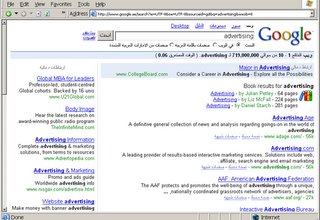
Offtopic but irresistibly amusing:
If you use Google but want to stand out from the crowd, use this Arabic version of the engine. Everything is inverted, with ads to the right and search stuff to the left. Notice how the scroll bar has moved to the right, too. Works with English searches, and you won't miss out on the ads for mortgage, either.
Instant Messenger as Content Delivery Platform

Not only can chat bots push ads, they can also intelligently deliver content on demand, and the bot for MAKE magazine is the first on the field:
"The MAKEbot is a AIM/iChat buddy you add to your buddy list. When you type latest, he will give you the latest news from Makezine.com. You can type "subscribe 1" and he'll deliver the latest news each hour. If you type "photos" you'll get the latest photos from the MAKE photo pool, type "bookmarks" you'll get our latest bookmarks, type "Instructables" you'll get the latest how-to projects. Lastly - if you type keywords like psp, welding, ipod or whatever he'll search the MAKE site, the pages from MAKE and give you a link from our search engine to help you find what you're looking for."
Firefox Users Click Less, Kill Ads
Horror! "Firefox users click through to Web site ads four to five times less often than do users of Microsoft's Internet Explorer, a German Web-advertising firm said Friday" (said TechWeb).
And to add injury to insult, Wired just came out with a list of must-have Firefox extensions, many of which are advanced ad-killing machines: "A lot of people swear by Adblock and other advertising-blocking extensions. But none have the ve rsatility and pure, fly-swatting satisfaction of Nuke Anything Enhanced. The concept behind this add-on is simple: Point at something and right-click (on PC) or cntl-click (on Mac) and select "Remove this object." Whatever piece of the page you clicked on just goes away -- poof!"
And to add injury to insult, Wired just came out with a list of must-have Firefox extensions, many of which are advanced ad-killing machines: "A lot of people swear by Adblock and other advertising-blocking extensions. But none have the ve rsatility and pure, fly-swatting satisfaction of Nuke Anything Enhanced. The concept behind this add-on is simple: Point at something and right-click (on PC) or cntl-click (on Mac) and select "Remove this object." Whatever piece of the page you clicked on just goes away -- poof!"
Personal Audio Avatar
"iTunes Signature Maker (iTSM) analyzes your music collection and creates a short audio signature to represent who you are and what you listen to." Really cool. This is like a personal radio jingle. If you want to try it for yourself, hurry up before Diggers and Slashdotters jam the bandwidth.
-- via Unmediated
-- via Unmediated
Local.Live Detailed Satellite Images

That's how detailed the images (click pic to zoom in) on Microsoft's local.live.com are. Not all cities are there yet, but what's there is pretty stunning. The coolest thing is that you can rotate the image to view an object from all sides. Not as polished as Google Maps in terms of interface yet, and Firefox compatibility is buggy, but very exciting nevertheless. Judging by this pic of my dorm, the images are pretty fresh, too. The road construction was happening last spring. A similar pic on Google is at least a decade old.
Flavored Magazine Inserts

Are you print adverts in good taste? (Sorry, couldn't resist). Anyway, the NY Times Magazine runs its traditional "The Year in Ideas" feature, and besides mentioning a bunch of MIT Media Lab's gadgets, it features flavored paper. Check this out:
"At Chicago's trendy Moto restaurant, a 20-course tasting menu can begin with "sushi" made of paper that has been printed with images of maki and wrapped around vinegared rice and conclude with a mint-flavored picture of a candy cane.
Homaro Cantu, Moto's executive chef, has essentially combined a high-end kitchen with a Kinko's. Using a modified ink-jet printer and organic, food-based inks, he prints images of food (and other objects) on specially designed paper made of modified food starch. Recently, he began creating flavored inserts for magazines."
Other notable mentions include forehead billboards and scientists auctioning off names of obscure organisms to outfits like Golden Palace.
The Value of Full RSS Feeds, Ads
Guardian discusses the value of full versus truncated RSS feeds and the effectiveness of RSS ads. The money quote: "Online marketing expert and blogger Michael Gray (wolf-howl.com) agrees. He says advertising in RSS is "horrible" and the resulting revenue won't come close to what can be achieved with web page ads."
How To Create Post-It Art

A very detailed step-by-step how-to on how to create amazing wall art from Post-It notes.
And some more art made from Post-It notes that turned 25 this year.

Future: Very Direct Marketing

Today's direct response marketing is still not terribly direct; after seeing an ad and dialing the number or clicking the link you still go through a number of extra layers that separate you from the desired product. Imagine a future, though, in which you see an ad, act on it, and the product arrives to you the next instant. One way to do it, besides teleportation, is through the 3D printers that create products on demand right in the living room of the customer. Today these printers cost around $25,000 and their functionality is limited, but hey, whatever computers and copiers they had 30 years ago were pretty much off limits to the general public as well. Instead of paying for the products themselves, you would effectively pay for the design algorithms behind them; the algorithm would be remotely fed into your printer once the transaction is approved. Forget DRM debates around music sharing; the Napsters, Kazaas and BitTorrents of the future would be trading product designs.
This little aside was inspired by a post at We Make Money Not Art about a student project that resulted in real working products printed on a machine.
-- image credit: zCorp
This Week on Billboardom
This week in Billboardom (here's last week, too):

A mini-compilation of anti-McDonalds billboards by culture jammers.

The "Person of the Year" billboard for Time mag.

A billboard that turned a skyscraper into a giant speaker.

Political billboards in Second Life.
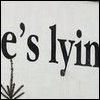
A billboard puzzles folks in Madison.

A mini-compilation of anti-McDonalds billboards by culture jammers.

The "Person of the Year" billboard for Time mag.

A billboard that turned a skyscraper into a giant speaker.

Political billboards in Second Life.

A billboard puzzles folks in Madison.
TiVo Puts Video Blogs on TV Screen
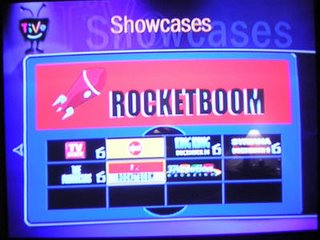
"The TiVo Videoblog Project is currently experimenting with ways to make the new medium of videoblogs accessible on television. If you have a videoblog or are interested in participating, please fill out this form." Rocketboom is the first v-blog to come to your living room courtesy of TiVo.
-- via zatznotfunny
Brand Magic

If you are into brand management, then you know that much of your job is about creating a sense of magic around the brand. And nothing screams magic more than having your product impossibly stuffed into a generic bottle. Here and here you'll find more great examples. You'll have to figure out how it's done on your own, or you can peek at the spoiler after the jump.
-- via BoingBoing
Earlier:
Corporate Magic
Spoiler: Microwave helps with the balls. Many other things are disassembled, stuffed in, and then assembled back inside the bottle.
Digital Management of Advertising Assets
A while ago, I bumped into this magnificent Harley Davidson ad planner that allows individual dealers to customize their ads with content specific to their local markets while maintaining the overarching look and feel.
After digging deeper, I found this paper that "reviews how some advertising agencies in the USA and Europe — Ogilvy, McCann Erickson, Grey Worldwide, BBDO, Leo Burnett Worldwide, Euro RSCG, Publicis’ Capps Digital and TracyLocke — chose and implemented a flexible, scalable digital asset management (DAM) system that allows them to collaborate via the internet with hundreds of agency offices and clients, worldwide."
I mean, there must be an intelligent substitute to the network folders, email and FTP.
Update (Jan 31 '06): BrandMuscle provides some of the advertising automation services, much like the Harley's ad planner.
After digging deeper, I found this paper that "reviews how some advertising agencies in the USA and Europe — Ogilvy, McCann Erickson, Grey Worldwide, BBDO, Leo Burnett Worldwide, Euro RSCG, Publicis’ Capps Digital and TracyLocke — chose and implemented a flexible, scalable digital asset management (DAM) system that allows them to collaborate via the internet with hundreds of agency offices and clients, worldwide."
I mean, there must be an intelligent substitute to the network folders, email and FTP.
Update (Jan 31 '06): BrandMuscle provides some of the advertising automation services, much like the Harley's ad planner.
Toys Sync with DVD

This $50 toy from Hammacher and Schlemmer interacts with the DVD that comes with it. The DVD sends an electronic signal that communicates wirelessly from television to the doll. As the DVD plays, the plush doll reacts to the program, giggling, singing, and flashing its integral lights.
Someone needs to design a toy that giggles, sings along and drools during commercial breaks. No more channel surfing.
-- via I4U
Tesco Launches Musical Sandwich
"Britain's largest retailer Tesco is launching musical sandwich. Tesco will use technology similar to that used in singing greetings cards to sell musical sandwiches. Opening the top of the sandwich box will activate a tiny sound module that plays a selection of music. This season's offering will be a medley of Christmas tunes including Jingle Bells, Santa Claus is Coming to Town, and We Wish You a Merry Christmas."
-- CNET
Earlier:
Sound Inserts in Print Ads
Musical Greeting Cards
Talking Packaging
Talking "Post-it" Button
-- CNET
Earlier:
Sound Inserts in Print Ads
Musical Greeting Cards
Talking Packaging
Talking "Post-it" Button
PlasticLogic Develops Large E-Ink Display
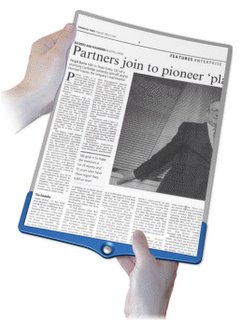
"Plastic Logic has developed the world's largest flexible organic active matrix display. The display consists of a flexible, high resolution, printed active-matrix backplane driving an electronic paper frontplane from US-based E Ink Corporation. The displays are 10" diagonal SVGA (600 by 800) with 100ppi resolution and 4 levels of greyscale. The thickness of the display when laminated with E Ink Imaging Film is less than 0.4mm."
-- press release
More Details on TiVo's Searchable Ad Model
Inside Branded Entertainment: "In the near term, the TiVo search system will remain as small as its customer base, which will likely grow with Comcast distribution next year. Yet if successful, agency executives say, it could migrate to video-on-demand cable systems and other DVR operators, making TV more Web-like.
In addition to giving viewers more control over what ads they see, such a system promises to bring a dose of accountability to TV advertising. Mimicking the ad-search system on Google, TiVo executives said they are discussing performance-based pricing models with media agencies, such as price-per-click and time-per-view variables, according to Davina Kent, vp of ad sales at TiVo.
TiVo has a fair amount of evidence from its other on-demand ad offerings, including clickable tags in commercials and TiVo Showcases of branded entertainment offerings, that viewers will seek out marketing messages. TiVo has seen click rates of 10 to 15 percent for campaigns it has run through TiVo Showcases, with viewers typically interacting with a marketing message between two and four minutes."
-- via AdJab
Earlier:
TiVo to Launch Searchable Advertising on Demand
In addition to giving viewers more control over what ads they see, such a system promises to bring a dose of accountability to TV advertising. Mimicking the ad-search system on Google, TiVo executives said they are discussing performance-based pricing models with media agencies, such as price-per-click and time-per-view variables, according to Davina Kent, vp of ad sales at TiVo.
TiVo has a fair amount of evidence from its other on-demand ad offerings, including clickable tags in commercials and TiVo Showcases of branded entertainment offerings, that viewers will seek out marketing messages. TiVo has seen click rates of 10 to 15 percent for campaigns it has run through TiVo Showcases, with viewers typically interacting with a marketing message between two and four minutes."
-- via AdJab
Earlier:
TiVo to Launch Searchable Advertising on Demand
E-Paper Display in Tokyo
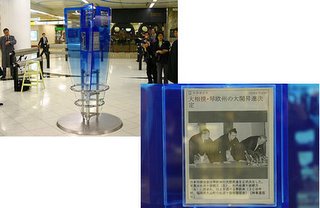
"A new display set up at Tokyo station makes interesting use of e-paper. Six A4 sheets of e-paper are on display for commuters in a snazzy transparent blue housing — allowing them to see how thin the e-paper is. The sheets of e-paper are being fed with the latest news stories via a wireless Internet connection and are updated with new content every five minutes."
-- Gizmodo
Nielsen to Measure Billboard Exposure with nPod

Nielsen Outdoor is introducing a new device called Nielsen Personal Outdoor Device (Npod) to measure actual exposure to outdoor displays.
"The Npod, a device resembling a cellphone, weighs 1.4 ounces and is equipped with a global positioning system. The Nielsen Outdoor unit of Nielsen Media Research had 850 consumers in the Chicago area carry one for nine days during the summer of 2004, tracking their movements past outdoor signs.
The participants' travels - on foot, in cars and on trains - were plotted on maps showing the locations of outdoor signs, thus indicating who passed by certain billboards, posters on bus shelters and other signs. The data could track exposure to the outdoor ads but could not determine if a person actually looked at or read them.
At a presentation to reporters yesterday in Midtown Manhattan, Nielsen Media Research, part of VNU, shared results from the Chicago market based on data gathered by the Npod. The research found, for instance, that the average resident in the Chicago area, age 18 or older, is exposed to 40 outdoor signs a day, a figure that rises to 66 for adults who live in the city.
The presentation was a prelude to the company's announcement of plans to introduce an Npod-centered audience measurement system in major markets for outdoor advertising. The plan is to be introduced in initial markets in April 2006; the eventual goal is a system that would operate around the world."
-- NY Times via AdPulp
Earlier:
Glasses Track Eye Movement, Ad Exposure
Business Week: Google Publication Ads Off To Slow Start
Business Week: "A closer look at Google's foray into magazine ads suggests it could be in for a tough slog. Sure, plenty of publishers are clamoring to snare ad dollars from Google. But a BusinessWeek analysis of Google's pilot, including interviews with 10 advertisers and two publishers, indicates that advertisers haven't warmed to the program so far. Only one of 10 advertisers interviewed by BusinessWeek said their print ad performed well enough to recoup the money it cost. And eight of the 10 were unhappy enough with the results that they say they're unlikely to do further print advertising with Google."
Flip-Flop Advertising

"These sturdy foam-core flip-flops are built into a sheet of printed foam. The foam sheet and the soles of the flip-flops are printed with advertisements taken from Chinese newspapers."
-- via Make
Earlier:
Branding Coffee Stains
Ads On Sand
Study: Ads in Video Games Drive Persuasion, Costs Rise
"Activision and Nielsen Entertainment released the results of a pioneering study on the effectiveness of in-game advertising that incorporates different levels of product integration. The research is the fourth component of an ongoing joint initiative between the two companies to establish standardized tools to measure the value of in-game ads.
The study confirms earlier findings that product integration helps to drive awareness and recall, but also uncovers a new variable, pervasiveness, which contributes to driving brand awareness as well. Most important, the research shows that the combination of product integration and pervasiveness results in a high degree of persuasion -- the willingness of consumers to change their opinions of a brand and/or recommend it to others -- and establishes that video games drive persuasion."
-- The Adrenaline Vault
"Next year, cellphone maker Nokia is doubling to 10 the number of games in which it will advertise, and the world's largest independent game maker, Electronic Arts, which had one game with ads in 2002, will have product placements in at least half of the 30 titles it releases next year.
Costs for advertising in video games have grown exponentially. They can range from $5,000 to $500,000, prices that rival spots in small films, according to some agencies."
-- Boston Globe
Also:
Here's the official press release.
Here are some earlier findings of the same study.
The study confirms earlier findings that product integration helps to drive awareness and recall, but also uncovers a new variable, pervasiveness, which contributes to driving brand awareness as well. Most important, the research shows that the combination of product integration and pervasiveness results in a high degree of persuasion -- the willingness of consumers to change their opinions of a brand and/or recommend it to others -- and establishes that video games drive persuasion."
-- The Adrenaline Vault
"Next year, cellphone maker Nokia is doubling to 10 the number of games in which it will advertise, and the world's largest independent game maker, Electronic Arts, which had one game with ads in 2002, will have product placements in at least half of the 30 titles it releases next year.
Costs for advertising in video games have grown exponentially. They can range from $5,000 to $500,000, prices that rival spots in small films, according to some agencies."
-- Boston Globe
Also:
Here's the official press release.
Here are some earlier findings of the same study.
Email Design Guidelines
If you advertise your goodies by email and use fancy (or any) graphics, you won't be thrilled to know that more than half of your readers will see nothing but a bunch of empty placeholders due to many popular clients' default settings. Campaign Monitor comes out with a handy list of email design guidelines:
- Never use images for important content like headlines, links and any calls to action.
- Use alt text for all images for a better experience in Gmail and always add the height and width to the image to ensure that the blank placeholder image doesn't throw your design out.
- Add a text-based link to a web version of your design at the top of your email.
Ensure your most compelling content is at the top (and preferably to the left). - Test your design in a preview pane, full screen and with images turned on and off before you send it.
- Ask your subscriber to add your From address to their address book at every opportunity.
Book: Life After the 30-Second Spot
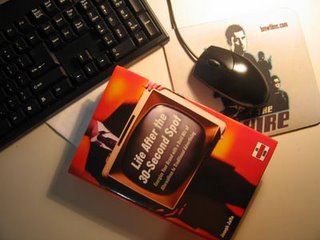
If published a decade ago, this book would've been revolutionary, five years ago - grounbreaking. Today, it's stating the obvious. If your RSS reader is tuned to the industry blogs (Jaffe's own, for example), most of the things Jaffe writes about are already familiar to you, and your response to the book will fall somewhere in between "this has been said before" and "do we even need to talk about this?"
Then there's the "what the hell is he talking about" type, and that's the people to whom Jaffe addresses his book, although whether he will succeed in changing these minds remains to be seen.
Jaffe is talking about interesting things. The book deals with The Big Question - what's next - and the next are the ten approaches that Jaffe says will steal the TV spot's thunder and money. He makes a solid case for each, although the distinctions at times feel somewhat unclear (Internet and search are profiled separately, and so are branded entertainment and long-term content). One of the most interesting parts of the book deals with DVRs, and Jaffe looks beyond the horizon to recognize TiVo as advertisers' friend that will bring the effectiveness of online context advertising to the TV screen through ads on demand.
This 275-page necrologue of the 30-second spot covers a lot of ground and as a result has more width than depth, which will suit generalists but will leave specialists craving for more. There's plenty left for a potential sequel; packaging and point-of-sales being the prime candidates.
The examples Jaffe uses to support his arguments are as recent as this year's, which makes the book feel fresh and read more like a long magazine feature. The author coins a couple of new acronyms, the most prominent of which is RUE (relevance, utility, entertainment), which is Jaffe's alternative to ROI as an effectiveness metric. He also throws in a couple of signature soundbites, such as "Today, some 65 year later after it [the 30-second spot] was first used, it is like Sean Connery - still sexy as hell but not much of a long-term prospect." The venerable and perhaps unavoidable "I don't know which half of my advertising is wasted" quote will comfort the traditionalists among you.
On his blog, Jaffe mentions that he'd love for this book to be used in classrooms, and that's where this book fits best. A concise, well written overview of the future of advertising, Life After 30 would be like Darwin's "The Origin of Species" in a system dominated by the intelligent design theory.
Joseph Jaffe's Life After The 30-second Spot sells on Amazon for around $20. Published by John Wiley & Sons in May, 2005. Visit lifeafter30.com for a synopsis, updates and an entire chapter.
Target Offers Ads Via Dedicated RSS Feed

In addition to an email newsletter, Target is now offering its Target Weekly Ad circular via an RSS feed adjusted to subscribers' locations.
Interactive Fiction by Phone
One of the things I've been long advocating is taking advantage of what phones do best - voice communication. Combine this with AI chat bots sitting on top of the still-very-dumb IVR (interactive voice response) systems, and you have something amazing:
"Ifbyphone allows you to play interactive fiction (IF) by phone. However this is not through enabling your cellphone as a device that runs an IF interpreter, but rather through an interactive voice service. The parser text is read outloud to you via text-to-speech, and your voice commands are sent back to the parser via speech-to-text" (Writer Response Theory).
"Ifbyphone is a new media company focused on the distribution of recorded and text based information and family-friendly entertainment via voice. User features include fully personalized news reports, Email access, blog access, RSS aggregation, weather, detailed sports reports, voice chat and games."
Also,
AudioGames.net
"Ifbyphone allows you to play interactive fiction (IF) by phone. However this is not through enabling your cellphone as a device that runs an IF interpreter, but rather through an interactive voice service. The parser text is read outloud to you via text-to-speech, and your voice commands are sent back to the parser via speech-to-text" (Writer Response Theory).
"Ifbyphone is a new media company focused on the distribution of recorded and text based information and family-friendly entertainment via voice. User features include fully personalized news reports, Email access, blog access, RSS aggregation, weather, detailed sports reports, voice chat and games."
Also,
AudioGames.net
Interactive Mobile Television
"Norwegian broadcaster NRK and Swedish wireless equipment maker LM Ericsson announced what they say is the world's first test of interactive mobile television. During the six-week test, users can download a program for watching and interacting with the Norwegian youth music program Svisj on their mobile phones. Users can vote for the next music video by pressing a mobile phone key, and chat in writing with each other or the program leaders while watching the show."
-- Wired
-- Wired
Neuros Records Video Compatible Across Devices
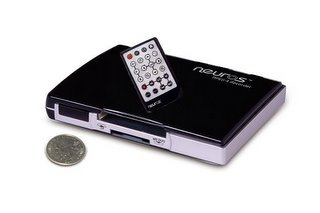
"The Neuros MPEG-4 Recorder is like an easy-to-use, free-standing VCR that records onto digital memory cards instead of VHS tapes so that the video is playable directly on the PSP or other handheld devices. The stand-alone device records from any video source (TV Cable box, Satellite Receiver Box, PVRs or DVRs Like TiVoTM, DVD players, VCR, Camcorders) into the MPEG-4 format that is compatible with most mobile devices. Records in three formats. Costs $149." Hurry up before its DRM-fighting maker is sued to death.
RSS Feed Hijacking
If you think content theft is bad enough, there's more bad news coming. eWeek writes about a case of podcast hijacking, where a thief has integrated someone else's podcast into his own site, the URL of which has appeared in big aggregators such as Yahoo and iTunes.
The guy, Marcus, wrote back to the thief asking him to redirect the podcast back to the owner. "Podkeyword honored his request, Marcus said, after which his listener numbers abruptly collapsed. Marcus came to find that Apple Computer Inc.'s iTunes service, which shields RSS information from its users, had also picked up the Podkeyword URL. Marcus contacted Apple, which has to date not fixed the URL.
Marcus then wrote back to Podkeyword to ask that his listing be temporarily reinstated on Podkeyword while he worked to fix things with Apple. Podkeyword reportedly responded that the listing would be reinstated only if Marcus provided an unspecified payment or agreed permanently to its terms."
The solution? Stick ads into your content and sit back while someone else builds your audience.
-- via Unmediated
The guy, Marcus, wrote back to the thief asking him to redirect the podcast back to the owner. "Podkeyword honored his request, Marcus said, after which his listener numbers abruptly collapsed. Marcus came to find that Apple Computer Inc.'s iTunes service, which shields RSS information from its users, had also picked up the Podkeyword URL. Marcus contacted Apple, which has to date not fixed the URL.
Marcus then wrote back to Podkeyword to ask that his listing be temporarily reinstated on Podkeyword while he worked to fix things with Apple. Podkeyword reportedly responded that the listing would be reinstated only if Marcus provided an unspecified payment or agreed permanently to its terms."
The solution? Stick ads into your content and sit back while someone else builds your audience.
-- via Unmediated
Monetizing Robotic Swarms

Roombas are moving from their janitorial work up the career ladder. Simon Fraser University in Vancouver is planning to release a swarm of 30 mini-robots that will communicate with each other.
The Engineer writes: "The $1,000 robots are 12 centimetre cubes that can see with infra-red eyes and communicate with flashing lights and sound – hence the name chatterbox. The robots are designed to work together on projects with no human intervention. One of their first jobs will be to map the building where they live. They will wander all over the place, taking measurements, but above all they will have to remember to get recharged. When they do need a sport of power, two large mother robots will deliver electricity to them."
How does it relate to advertising? You could release a bunch of these guys onto a supermarket floor and instruct them to follow shoppers and nag about buying more stuff. Just like those smart remote-controlled shopping carts. When "monetizing robotic swarms" becomes the buzz word of 2010, remember you heard it here first.
-- via We Make Money Not Art
Spyware War Is Over; Spyware Has Won
Wired runs a feature on Claria (a company formerly known as Gator), famous for serving pop-up ads that they called targeted to millions of innocent web surfers:
"At first blush, the news sounds like solid evidence that Claria has emerged from the spyware wars with a new focus. Having taken pop-ups as far as it could, the company has decided to leave the format behind. But this isn't to say it's finished tracking customers and using the information to sell advertising."
In other but related news, CNET writes that "Yahoo aims to boost the effectiveness of its advertising--and rates--by targeting ads to users based on their surfing behavior on its site, the company's advertising sales chief said on Thursday. Yahoo does not give personal information to advertising clients but tracks a few types of behavior by its users, including search queries, movement through Yahoo sites and the specific ads clicked. That lets it decide on the fly what ads are most appropriate for a user."
-- via AdPulp
"At first blush, the news sounds like solid evidence that Claria has emerged from the spyware wars with a new focus. Having taken pop-ups as far as it could, the company has decided to leave the format behind. But this isn't to say it's finished tracking customers and using the information to sell advertising."
In other but related news, CNET writes that "Yahoo aims to boost the effectiveness of its advertising--and rates--by targeting ads to users based on their surfing behavior on its site, the company's advertising sales chief said on Thursday. Yahoo does not give personal information to advertising clients but tracks a few types of behavior by its users, including search queries, movement through Yahoo sites and the specific ads clicked. That lets it decide on the fly what ads are most appropriate for a user."
-- via AdPulp
MIT Ad Lab's Top Ten November Posts
Here are some November stories that attracted the most attention, traffic, link-backs or comments, in case you've missed the action. Top October posts are here.
- "The Movies" game goes to retail, is expected to boost machinima movement.
- A research company tests goggles that track eye movement and measure ad exposure.
- Slingbox, a device that "place-shifts" TV viewing, is named one of the coolest inventions of the year.
- Google launched Google Publication Ads, extending its AdWords program to print media.
- An ad agency gets awarded for pulling an in-store stunt involving remotely controlled shopping carts.
- AtomShockwave said it would start brokering ads in casual games.
- Fruitcast began auto-inserting ads in podcasts.
- Microsoft said it was considering putting ads in productivity software as advertisers were once again growing anxious about reaching the desktops.
- Revver began inserting ads in amateur online video.
This Week on Billboardom
Again, more like "past few weeks on Billboardom", but whatever. Here's the previous update.

Argentinians commemorate World AIDS Day with a condom on an obelisk.

Really cool truck art, and the coolest thing is that it's not Photoshopped.

A bubble gum billboard.

A small collection of billboards spotted in San Andreas.
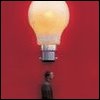
A billboard for The Economist with a flashing lightbulb.

A couple of billboards added to the Absolut outdoor collection.

Argentinians commemorate World AIDS Day with a condom on an obelisk.

Really cool truck art, and the coolest thing is that it's not Photoshopped.

A bubble gum billboard.

A small collection of billboards spotted in San Andreas.

A billboard for The Economist with a flashing lightbulb.

A couple of billboards added to the Absolut outdoor collection.
Human Locator's Interactive Targeted Billboards

"The Human Locator analyses a camera feed in real time, sending detailed information about people's location, size, and movements. This data is then used as input to control projections, video, graphic animations, and sound on window displays, inside shops or on public signage." Which probably means you can now show separate ads targeted to tall women or fat men. Or show more info to those who stop by and look at the billboard.
-- via We Make Money Not Art (I'm one year behind on this one).
Study: No Interest in Mobile TV
Yet another study stabs a needle in the mobile TV balloon. "Only 1 in 8 mobile customers are even interested in video on handsets, according to In-Stat research, while in a similar survey, Parks Associates found that only 12 to 13 percent of consumers say video/TV functions are important on any mobile device."
-- Media Post
Earlier:
Study: Demand for Mobile Video Weak
-- Media Post
Earlier:
Study: Demand for Mobile Video Weak
Subscribe to:
Posts (Atom)
